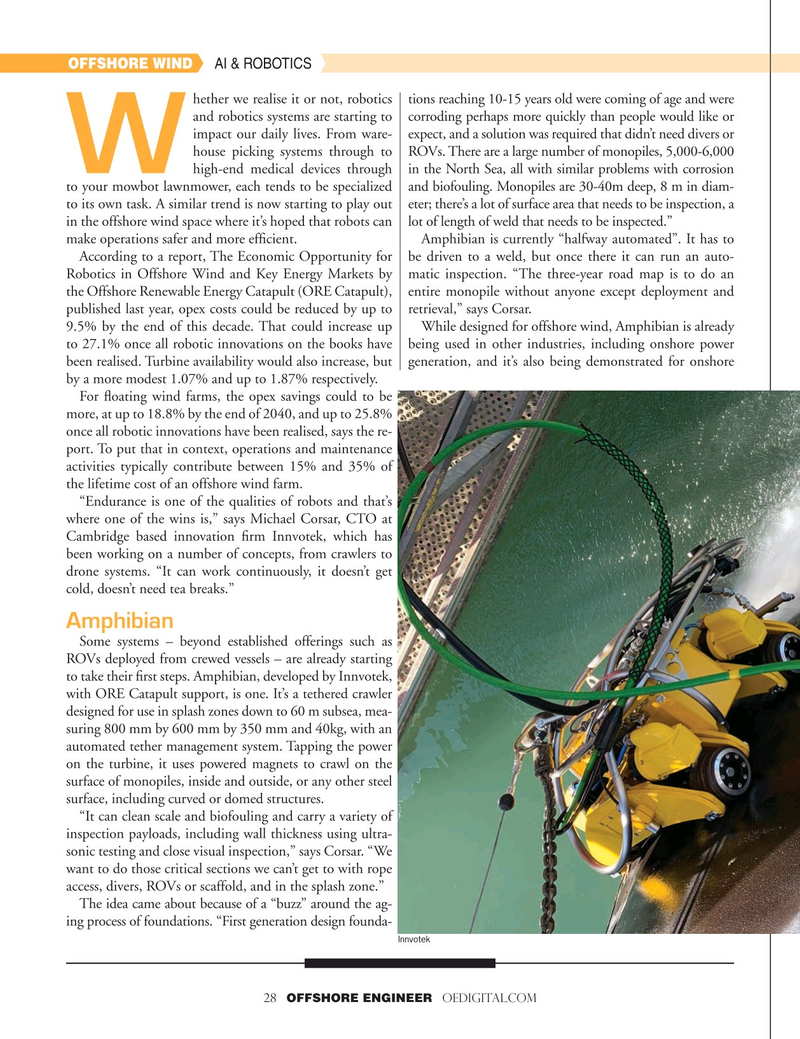
Page 28: of Offshore Engineer Magazine (Mar/Apr 2022)
Read this page in Pdf, Flash or Html5 edition of Mar/Apr 2022 Offshore Engineer Magazine
OFFSHORE WIND AI & ROBOTICS hether we realise it or not, robotics tions reaching 10-15 years old were coming of age and were and robotics systems are starting to corroding perhaps more quickly than people would like or impact our daily lives. From ware- expect, and a solution was required that didn’t need divers or house picking systems through to ROVs. There are a large number of monopiles, 5,000-6,000
W high-end medical devices through in the North Sea, all with similar problems with corrosion to your mowbot lawnmower, each tends to be specialized and biofouling. Monopiles are 30-40m deep, 8 m in diam- to its own task. A similar trend is now starting to play out eter; there’s a lot of surface area that needs to be inspection, a in the offshore wind space where it’s hoped that robots can lot of length of weld that needs to be inspected.” make operations safer and more ef? cient. Amphibian is currently “halfway automated”. It has to
According to a report, The Economic Opportunity for be driven to a weld, but once there it can run an auto-
Robotics in Offshore Wind and Key Energy Markets by matic inspection. “The three-year road map is to do an the Offshore Renewable Energy Catapult (ORE Catapult), entire monopile without anyone except deployment and published last year, opex costs could be reduced by up to retrieval,” says Corsar.
9.5% by the end of this decade. That could increase up While designed for offshore wind, Amphibian is already to 27.1% once all robotic innovations on the books have being used in other industries, including onshore power been realised. Turbine availability would also increase, but generation, and it’s also being demonstrated for onshore by a more modest 1.07% and up to 1.87% respectively.
For ? oating wind farms, the opex savings could to be more, at up to 18.8% by the end of 2040, and up to 25.8% once all robotic innovations have been realised, says the re- port. To put that in context, operations and maintenance activities typically contribute between 15% and 35% of the lifetime cost of an offshore wind farm.
“Endurance is one of the qualities of robots and that’s where one of the wins is,” says Michael Corsar, CTO at
Cambridge based innovation ? rm Innvotek, which has been working on a number of concepts, from crawlers to drone systems. “It can work continuously, it doesn’t get cold, doesn’t need tea breaks.”
Amphibian
Some systems – beyond established offerings such as
ROVs deployed from crewed vessels – are already starting to take their ? rst steps. Amphibian, developed by Innvotek, with ORE Catapult support, is one. It’s a tethered crawler designed for use in splash zones down to 60 m subsea, mea- suring 800 mm by 600 mm by 350 mm and 40kg, with an automated tether management system. Tapping the power on the turbine, it uses powered magnets to crawl on the surface of monopiles, inside and outside, or any other steel surface, including curved or domed structures.
“It can clean scale and biofouling and carry a variety of inspection payloads, including wall thickness using ultra- sonic testing and close visual inspection,” says Corsar. “We want to do those critical sections we can’t get to with rope access, divers, ROVs or scaffold, and in the splash zone.”
The idea came about because of a “buzz” around the ag- ing process of foundations. “First generation design founda-
Innvotek 28 OFFSHORE ENGINEER OEDIGITAL.COM

 27
27

 29
29